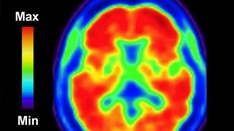NICE, France — In a phase 1 clinical trial, an investigational inhibitor of β-secretase 1 (BACE) penetrated the brain and reduced levels of β-amyloid (Aβ) in both plasma and the cerebrospinal fluid (CSF).
The still numbered compound, JNJ-54861911, decreased Aβ even after it was gone from plasma and CSF, indicating sustained pharmacodynamic activity.
"Our compound is a potent, brain-penetrant BACE inhibitor, achieving up to 95% Aβ reduction with once-daily oral dosing," Johannes Streffer, MD, from Janssen Research and Development in Beerse, Belgium, reported here at AD/PD 2015: International Conference on Alzheimer's and Parkinson's Diseases. Janssen Research and Development sponsored the study.
BACEs are enzymes that covert amyloid precursor protein to the shorter peptide forms of amyloid.
Participants were healthy adults, aged 55 to 85 years. They were randomly assigned to placebo or to a single initial daily dose ranging from 1 to 150 mg and subsequent daily doses of 5 to 90 mg for 14 days. Drug pharmacokinetic (PK) and Aβ pharmacodynamic measurements were made on plasma and CSF (via 36-hour catheterization).
The researchers assessed various forms of Aβ (Aβ1-37, 1-38, 1-40, 1-42), as well as soluble amyloid precursor proteins (sAPP) α and β. Because baseline levels of the amyloid proteins varied among the participants, the researchers expressed reductions as percentages of the initial predose levels.
Plasma and CSF Aβ1-40 Reduction
Maximal reduction in plasma Aβ1-40 occurred approximately 4 hours after day 1 dosing for all doses, and the degree of reduction was dose dependent. At doses of 3, 10, 30, 90, and 150 mg, the effect was sustained out to 36 hours. At the three highest doses, maximal mean plasma Aβ1-40 reduction was greater than 75%, and at the highest dose, was in the range of 90%.
Kinetics of Aβ1-40 loss from the CSF were slower than from plasma. Declines in CSF started only after 6 to 8 hours, and maximal reductions occurred at 24 hours. The 1-mg and 3-mg doses did not produce any significant reductions. At the highest doses, mean reductions were approximately 75%. The efficacy persisted, with a slow return to baseline.
The onset of plasma lowering of Aβ1-40 parallels the drug PK in plasma. However, Aβ1-40 lowering in CSF is disconnected from plasma or CSF drug PK. The rate of onset of CSF Aβ1-40 lowering is similar to the production rate of new Aβ1-40.
"It is plausible that plasma and CSF Aβ reductions are driven by peripheral and central activity, respectively," Dr Streffer deduced.
There were very stable reductions of Aβ1-40 in plasma and CSF at 36 hours postdose after 14 days of daily dosing, with maximal reductions of about 95% from baseline at the highest dose.
Baseline Aβ1-40 was not a significant covariate in terms of proportional reduction — that is, regardless of starting level, participants achieved similar percentage reductions in Aβ1-40. A 50% reduction was seen at the 6-mg dose, and doses of 50 mg or greater resulted in approximately 90% reductions in CSF Aβ1-40.
Table. Dose-Dependent Reduction in Steady-State Mean CSF Aβ1-40
| Dose (mg) | Proportional Reduction (%) |
| 5 | 48 |
| 10 | 63 |
| 25 | 80 |
| 30 | 83 |
| 50 | 89 |
| 90 | 94 |
The authors reported that results were similar for all four forms of Aβ peptides in CSF, but Aβ1-40, the most prevalent form in plasma and CSF, had the best assay characteristics. sAPPβ reduced in parallel with the other forms, whereas sAPPα increased 2- to 2.5-fold.
Although baseline levels of Aβ1-40, Aβ1-42, and sAPPβ differed depending on APOE ε4 carrier or noncarrier status, the status had no effect on the percentage reduction in these amyloid forms.
Zero Amyloid
John Trojanowski, MD, PhD, professor of geriatric medicine and director of the Institute on Aging at the University of Pennsylvania in Philadelphia, called the BACE data "amazing, even though they didn't present clinical data."
He commented to Medscape Medical News that the biomarker results showed "breathtaking reductions in Aβ." He anticipates that the clinical data will be presented at the Alzheimer's Association International Conference in July in Washington, DC.
Dr Trojanowski predicts that treatment of Alzheimer's disease (AD) will require aiming at more than one target, such as amyloid, secretases, TDP-43, tau, synucleins, and possibly more. Cerebrovascular disease is also a risk factor and needs to be aggressively treated in AD, he said.
Session moderator Colin Masters, MD, senior deputy director of the Florey Institute of Neuroscience and Mental Health in Victoria and a laureate professor at the University of Melbourne, Australia, also commented to Medscape Medical News that the drug looks very effective and promising.
"They can put out 90% inhibition at doses that are easily achievable," he said. "So the big question for [the sponsor] will be what sort of dose are they really aiming for? I think they may get away with a 50% reduction or a 20% reduction over a long period of time." He noted that such drugs will have to be taken for at least 1 to 2 years.
"You're trying to get the amyloid level right down to what we call zero," Dr Masters explained. But no one yet knows how much amyloid production needs to be shut down to make a difference in the disease, and it may take a couple of years to lower brain amyloid levels to what appears normal on brain amyloid imaging.
Dr Streffer is an employee of Janssen Research and Development, which conducted the study. Dr Trojanowski has received research funding from Biogen Idec for work not related to amyloid. Dr Masters is a consultant on the global advisory board for Lilly and has an interest in an unrelated company.
AD/PD 2015: International Conference on Alzheimer's and Parkinson's Diseases. Abstract #267. Presented March 20, 2015.
Medscape Medical News © 2015 WebMD, LLC
Send comments and news tips to news@medscape.net.
Cite this: New Drug Greatly Reduces Amyloid in CSF, Plasma - Medscape - Mar 24, 2015.









Comments